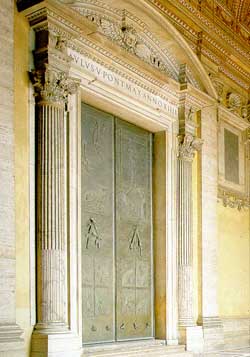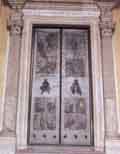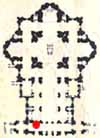| Grottoes
Vatican City Colonnade Saints Floorplan #2 |
| Altars
Monuments The History |
| Related
Items Holy Door Portico |

|
The Door of Death is so called because it used to be the exit for funeral processions. In preparation for the Holy Year of 1950, Pius XII held a competition for three new bronze doors to lead from the portico to the basilica. Of the winners, the most distinguished artist was Giacomo Manz¨. His door has large modeled panels of the Crucifixion and Annunciation, and lesser panels of prophets, apostles and saints. |
 |
 |
From:
Seminarians Guide
The Door of Death is on the far left. It used to be the exit for funeral
processions. Images: Death of Jesus (top right) and Death of Mary (top
left); violent death of Abel, serene death of Joseph, death of first pope,
death of Pope John XXIII, death of first martyr Stephen, death of Gregory
VII (died in exile defending the Church against the Emperor), death improvised
in space and death of mother at home.
From:
'St. Peter's - Guide to the Square and Basilica'
Five doors, corresponding to the five naves of the ancient and new buildings,
give access to the basilica. Four of them are the work of contemporary
artists, as a witness of the perennial vitality of the Church and her
capacity to awaken artistic inspiration in all ages. The scenes portrayed
on the doors invite the visitor to reflect on the significance of the
building he is about to enter, and on the meaning of his visit to the
basilica.
The first door on the left is called the Door of Death because at one time it was the exit for funeral processions. The scenes sculpted between 1961 and 1964 by Giacomo Manz¨ (1908-1991) in accordance with the wishes of John XXIII (1958-1963), express the Christian meaning of death in ten episodes. Above right: the Death of Jesus; the death of the Just who redeems and saves us; above left: the Death of Mary who is immediately borne to heaven, a sign of the sure hope of resurrection for all humankind. In the center, a vine branch (left) and some ears of wheat (right). From the ground grains of wheat and the pressed grapes are made the bread and wine which in the Eucharist become the bread of life and the drink of salvation. Below left: the Violent death of the innocent Abel, for whom God asks his brother Cain to account, and the Serene death of St. Joseph, patron of all who desire a holy death; the Death of the first Pope, St. Peter, hanging on a cross, but upside down, since he felt unworthy to die like his Lord, and the Death of Pope John XXIII, the good parish priest of the world whose death deeply affected people of all religions and nationalities; below right: the Death of the Protomartyr, St. Stephen, killed by those who had killed Jesus and, who like Jesus, prayed for and forgave his executioners; and the Death of Pope Gregory VII, who died in exile because he "loved justice and hated irreverence", defending the Church against the emperor's claims. Finally, Death improvised in space and the Death of the mother at home in front of the child she abandons. Under the panels are six creatures: a blackbird, a dormouse, a hedgehog, an owl, a tortoise and a raven. On the inside of the door can be seen the impression of Manzu's hand and a portrayal of John XXIII receiving the bishops on the first day of the Second Vatican Council, October 11, 1962.
From:
'St. Peter's Basilica - A Virtual Tour' by Our Sunday Visitor
The last door on the left of the Atrium, the Door of Death by Giacomo
Manzu' is perhaps the most authoritative contemporary work of St. Peter's
Basilica. Consecrated on June 28, 1964, by Paul VI, the door had been
commissioned by John XXIII, who died on June 3, 1963. Manzu', born in
the same region as the Pope, dedicated the door to him.
In fact, Pope John appears in the work, like the scene in which he embraces bishop Rugambwe on the papal throne, with incisive physionomical features. It is also easy to recognize his friend and adviser Don De Luca, who died in 1962 and to whom Manzu' officially dedicated the door in the inscription with the Pope's consent.
The episodes of death, including violent events, express painful suffering, since they are represented after they have occurred, and thus extol through the catharsis of repentance. Manzu' is able to express his view of humanity quite spontaneously, focusing on its culminating moment, thanks to the simple freshness of the images and their sculptured transposition in delicate and light projection, with a constructive luminism that pervades the forms.
Six zoo-morphical symbols that allude to Death are inserted at the bottom; in the center, the two essential symbols of Christianity, a vine shoot and a bundle of wheat spikes, act as handles. The soft and suffuse plastic-luministic effect of the bas-reliefs is the result of "the quality of the bronze alloy, specially studied and developed by the artist together with his founder," as Orienti said.
From: 'The Companion
Guide to Rome' by Georgina Masson
Filarete's bronze doors are flanked by three other modern ones, of which
the first pair on the left are the most striking. They are the work of
Giacomo Manz˙, one of the winners of a competition held in 1947. The main
subjects of his composition are the Death of Christ and the Death of the
Virgin, but n the back the sculptor has included a relief of the Vatican
Second Ecumenical Council and of Pope John XXIII conversing with Cardinal
Rugambwa of Tanganyika; obvious parallels to Filarete's reliefs of the
Council of Florence and the Ethiopian monks, who came to Rome on 10 October
1441.
From: Giacomo
Manz¨ and his portal for St Peter's by Peter Selz, Sculpture, December
2001
Giacomo Manz¨, who in the 1960s produced the large, bas-relief bronze
doors for St Peter's Basilica in Rome, has just about vanished from critical
attention, especially in the U.S. He was widely respected for his ability
to bring the Italian Humanist tradition to Modernist concerns of sculptural
form in space. An atheist, a man close to the Communist Party of Italy,
he was chosen to carry out this major work on the fašade of the supreme
church of Christendom, originally designed by Bramante and Michelangelo.
Although a master of bronze, Manz¨ did not allow the medium to dictate the message. Not a formalist, he recognized the social purpose of art and considered it to be more than a form of self-referential expression. He was well aware that art, especially public sculpture, has the potential for shaping ideas and beliefs. But he had no desire to present his message as propaganda, the style so popular with the Fascists who had terrorized Italy during his youth. He knew that art that is implicit in connotation is art that is most memorable, functioning on a deeper level. In this sense, he is indeed our contemporary.
Produced during the
years following the death and destruction of World War II and the total
terror of Auschwitz and Hiroshima, the Door of Death on the west fašade
of St Peter's is a metaphor for human suffering and dying. The door also
marks the artist's rejection of the reification of modern life that puts
the human being in danger of becoming nothing more than another material
object. In creating the Door of Death, Manz¨ showed his contemplation
of man's ultimate predicament. The great portal can be seen as a dialectical
play between the sacred and profane, performed in bronze.
ůů.
The two large reliefs in the upper register depict the Death of Mary and
the Death of Christ. The former is placed high on the door so that the
viewer must look up at the fluttering folds of drapery which signify angels
in flight, descending with their arms reaching out toward the Virgin,
suggesting - but by no means illustrating - the tenet of her Assumption.
The curve of flight of the lower angel is echoed by the posture of the
attendant to the Crucifixion. It establishes a circular link between the
angels, the body of Mary, the attendant, and the figure on the Cross.
Christ is depicted without the stigmata, as a young man hung by a rope
from the crossbar. Standing at the right of the Cross, in the place usually
given to Mary, we see Eve weeping, her head nestled on her arm. The long
rope extends to the bottom of the Cross, where its end appears like the
head of a serpent, symbolically relating the Crucifixion to the Fall of
Man. Close to the viewer's eye, the lower reliefs, almost square in shape,
deal with further themes of death. The upper four panels depict death
coming to sacred personages, while the ones below show common mortals
seen in contemporary terms. There is Death by Violence, with the naked
victim hanging upside down. This relief recalls Manz¨'s earlier work Death
of a Partisan, and it may also refer to the display of the corpse of Mussolini
in Milan's Piazza Loreto in 1945. The image is all the more effective
for remaining ambiguous and allusive, rather than directly tendentious.
Next to this scene of horror is the solemn presentation of the aged Pope
John XXIII, alone and bent in silent prayer. The "Papa buono" was the
artist's patron, compatriot, and eventually his friend.
Perhaps the most intensely moving relief is Death on Earth on the bottom right - the final work in this narrative on the theme of mortality. An exhausted and anonymous woman leaning on a falling chair meets her end under the eyes of a child, frightened and crying in pain as he witnesses the death of his mother. The gentle delicacy of the modeling by the master's hand infuses the experience of death with a compelling gravity. A void separates the child in his rectangular window frame from his mother whose figure sweeps diagonally across the lower area. We are reminded of the cogent statement by the Italian-American artist Rico Lebrun that "pain has a geometry of its own."
The Door of Death is far from being a depiction of violence. It is, rather, a work that stands out for its gentle tenderness in the face of death, evoking sorrow. Manz¨'s friend, the anti-Fascist writer Carlo Levi wrote of the portal: "Deprived of sin and therefore redemption, Death appears in that unique moment, that fixed instant in which the violence of nature turns to harmony: a unity of expression which embraces the dead and the living, the victims, the witnesses, and the killers."
After 16 years of
work on the doors, Manz¨ signed the work with the imprint of his right
hand. When Pope John XXIII died in 1962, Manz¨ cast the death mask of
the pontiff's face, as well as the hand that had signed the great encyclical
Pace in Terris.
-Peter Selz (reprinted in part)

